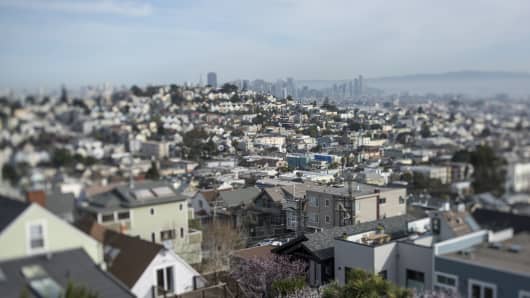For $1,200 a month, Patricia Torres and her family were renting a bedroom, a share of time in the bathroom, one vegetable drawer and one shelf in the fridge, and two cupboards over the stove. They rented not so much a home as a fraction of one.
Karen Calderon had even less: a single room in a homeless shelter where she was not allowed so much as a hot plate to cook for her family.
Adrian Caratowsa had a studio he'd remade as his own, repainting the walls and wallpapering over the kitchen cabinets. But every day for five years, he walked out into a neighborhood he found depressing.
For each, San Francisco's housing crisis had meant living without essential elements of home. A large affordable housing development rising downtown promised what they did not have: 95 complete homes, one-, two- and three-bedroom apartments with privacy, a sense of peace, a place to cook.
The development, Natalie Gubb Commons, was reserved for households with incomes up to 50 percent of the local median. The applications were open for three weeks last fall, and 6,580 households applied for a chance to rent there, or nearly 70 for each unit.
As the development neared completion, Congress was closing in on a tax overhaul whose central goal — a much lower corporate tax rate — would make it harder to finance projects like this one, in a time of acute housing need. By one estimate, the bill would erase 235,000 affordable rental homes nationwide over the coming decade — one in six of those that might have been built or renovated without tax code changes.
With affordable housing scarce and likely to grow more so, San Francisco planned to draw winners for Natalie Gubb Commons at random.
Subsidized housing is often rationed this way, by lottery. Many apply, few win, most are disappointed. The process is meant to be more fair than first-come, first-served. But lotteries make literal a deeper unfairness. For homeowners, the mortgage interest deduction is available to anyone who qualifies. For poor renters, there is never enough housing assistance to go around.
Lotteries that allocate scarce resources are not set up to distinguish the neediest from the merely needy. Rather, they reward random chance, which is a distinctly different notion of what's "fair."
Ms. Calderon and her husband had been looking for a home for two years, since the last landlord learned of the third child on the way and told them they had to go. They could afford a studio, a one-bedroom maybe, but no one Ms. Calderon called would rent such a small space to a family of five. So they slept in their car, with a newborn, for months. They entered one homeless shelter, then another.
Ms. Calderon asked everyone she knew with a home how they did it. The market seemed a mystery, requiring some inside connection. She knew no one who'd won a home, but she was eager to try, exchanging her application for an eight-digit lottery number.
"I think about the number all the time — when I get up, during the day, and at night when I'm going to bed," Ms. Calderon said in Spanish early last November, before those 6,580 numbers were fed into a computer, randomized and ranked. "Sometimes it wakes me up at night, thinking that they're going to tell me, 'Here are the keys to your apartment.'"
'A place where I feel like I have hope'
Mr. Caratowsa walked by Natalie Gubb Commons a week before the lottery, as he had several times before. Scaffolding still obscured two sides of the development. The west-facing facade had come into view, eight stories of industrial-chic gray.
"Imagine the view you'd have from this window," Mr. Caratowsa said, glancing up. He pictured himself on one of the upper floors, facing Fremont Street. He had long coveted the neighborhood for all the success that could be seen from that window: the luxury condos; the tech offices; the Salesforce Tower, the tallest skyscraper in the city.
Mr. Caratowsa, 31, had been living in another affordable building in the Tenderloin district, where the city's homeless and addiction services are concentrated. He'd been on disability most of his adult life, living with years of pain after complications from a series of operations in his early 20s. He'd been H.I.V.-positive since childhood, and a subsidy from the San Francisco AIDS Foundation helped pay his rent.
He could see himself absorbing the city's energy here, getting off disability, getting to work. He knows that he does not look like most of the office workers here, covered in his tattoos that commemorate travels and pain he has overcome. But he liked to stroll toward the Financial District downtown, where everyone appeared to be going places.
"To walk downtown, seeing people in suits, going to work, they have their coffee in their hand — to me it's like when a little girl wants to be a princess and she wears her mom's high heels," Mr. Caratowsa said. "That's me being in the Financial District. It's just a place where I feel like I have hope."
Amid all the wealth in this neighborhood, a one-bedroom at Natalie Gubb Commons would rent for around $1,000 to $1,200 a month, a three-bedroom up to $1,700. Apartments next door were three times as much.
That discount is possible through a mix of resources. Mercy Housing, the project's nonprofit developer, effectively got the land free as part of a city requirement that the neighborhood's redevelopment include affordable housing. The market-rate developer next door was subsidizing the project, along with city funds. Revenue from the state's cap-and-trade emissions program helped. And Mercy used the backbone of nearly every affordable housing project in America, federal Low-Income Housing Tax Credits.
